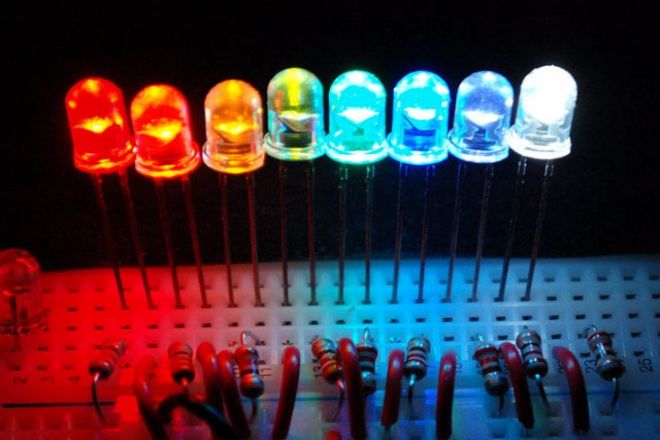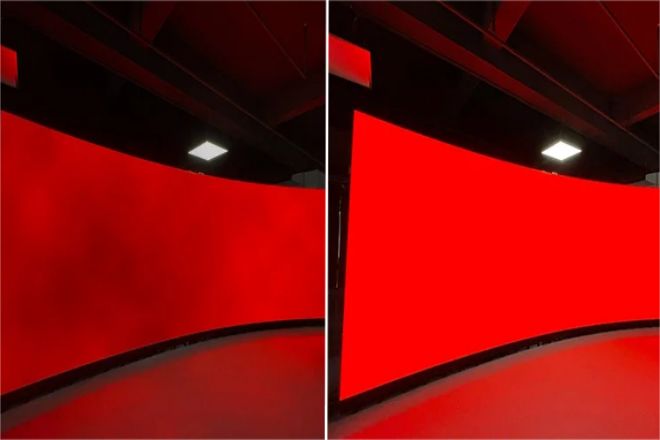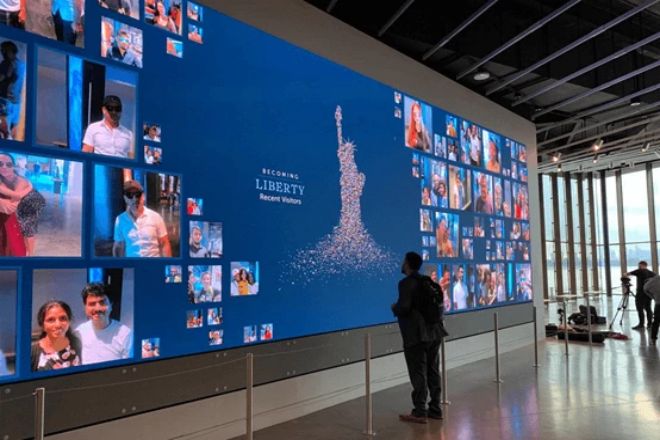介绍

在当今数字化、信息化的时代, LED显示屏 已成为信息传播、广告展示、文化娱乐等领域不可缺少的重要工具,其高亮度、高清晰度、长寿命等特点使其在各种场合都能有出色的表现。
但由于LED显示屏的色调是直接影响观众视觉体验的关键因素,因此对它的调整和优化就显得尤为重要。
1、LED显示屏色彩色调基础知识

LED显示屏色调基础知识涵盖很多方面,下面针对您的问题进行详细解答:
1). 色彩基础:色相、明度和饱和度
- 色调:
色相是色彩的本原特性,是区分各种色彩最准确的标准。其实,除黑、白、灰以外的任何色彩都具有色相的属性,而色相又由原色、间色、复色组成。色相环是色相最直观的体现,可以清晰地反映出色彩之间的关系和变化。
- 价值:
明度是指颜色的明亮程度。各种颜色的物体,由于反射光的多少不同,而产生颜色的明暗。颜色明度有两种情况:一是色相相同,但明度不同;二是各种颜色的明度不同。
- 饱和:
饱和度是指色彩的鲜艳程度,又称色彩的纯度。饱和度取决于色彩中彩色成分与无彩色成分(灰色)的比例。彩色成分越大,饱和度越大;无彩色成分越大,饱和度越小。
2).LED显示屏色彩生成原理
- RGB色彩模式:
RGB色彩模式是业界的一种色彩标准,通过改变红(Red)、绿(Green)、蓝(Blue)三个颜色通道并相互叠加,得到各种各样的颜色。RGB代表的是红、绿、蓝三个通道的颜色,该标准几乎囊括了人类视觉所能感知的所有颜色,是应用最为广泛的色彩系统之一。
- 色彩深度和分辨率:
色深是指显示器能够显示的颜色数量,通常以位(bit)表示。色深越高,显示的色彩越丰富,画面越细腻。分辨率是指显示器上的像素数量,通常以水平像素数和垂直像素数表示。分辨率越高,显示越清晰。
3).色调调整的重要性
- 改善视觉体验:
通过调整LED显示屏的色调,可以使其更加符合人眼的视觉习惯,从而提高观看体验。例如,在显示自然风光图片时,适当增加绿色和蓝色的饱和度,可以使画面更加清新自然。
在展示产品图片时,调整色调和亮度可以凸显产品的特点,吸引观众的注意力。
- 确保信息传递的准确性:
LED显示屏显示信息时,准确的色调可以保证信息的准确传递。例如,在显示交通标志时,红色停止标志和绿色通行标志都有明确的色彩规定。如果色彩不准确,可能会导致误解和安全隐患。因此,通过调整LED显示屏的色调,可以保证信息的准确性和可靠性。
2.LED显示屏色调调整方法
LED显示屏色彩色调的调整方法通常有软件调整和硬件调整,以下是具体调整方法及步骤:
1). 软件调整
1.1).使用LED显示屏控制软件
颜色校准:
很多LED显示屏控制软件都提供了色彩校准功能,利用该功能可以对显示屏的色彩进行精确的调整,使其更加准确、逼真。
预设模式选择:
很多软件都提供了多种预设模式,例如标准、鲜艳、柔和等,用户可以根据自己的实际需要选择合适的模式,快速调整显示的色调。
自定义颜色设置:
除了预设模式外,用户还可以根据需求自定义色彩设置,通过调节红、绿、蓝三原色的亮度,实现各种色彩的组合和变化。
1.2). 调整步骤详解
连接显示屏与控制软件:
首先,需要将LED显示屏连接到控制软件。这通常需要使用特定的电缆或无线连接。
进入颜色调整界面:
连接成功后打开控制软件,进入色彩调整界面,此界面一般显示当前显示器色彩设置和预览效果。
根据需要调整颜色:
在色彩调整界面,用户可以根据实际需求进行色彩调整。使用色彩校准功能进行精确调整,或者选择合适的预设模式或自定义色彩设置。
保存并应用设置:
调整完成后,记得保存并应用设置,这样LED显示屏就会按照新的颜色设置进行显示。
2). 硬件调优
2.1).更换LED灯珠或模组。
选择合适的LED灯珠或模组:
如果LED显示屏的色调出现严重问题,则可能需要更换LED灯珠或模组。更换前需要选择合适的LED灯珠或模组,确保与原有显示屏兼容,满足使用要求。
更换流程及注意事项:
在更换LED灯珠或者模组的时候需要注意以下几点:首先,一定要确保显示屏处于关闭状态并且断开电源;其次,一定要按照说明书或者专业人员的指导进行拆卸和安装;最后,更换完成后进行测试,确保显示屏功能正常。
2.2).调整显示亮度和对比度。
使用显示器上的物理按钮或遥控器:
大部分LED显示屏都带有调节亮度、对比度的实体按键或者遥控器,用户可以通过这些按键或者遥控器进入设置界面,然后按照提示进行调节。
亮度和对比度对色调的影响:
亮度和对比度是影响LED显示屏色彩色调的重要因素,适当提高亮度,可以使画面更加明亮、鲜艳;适当提高对比度,可以增强画面的层次感和立体感。
但需要注意的是,过高的亮度或对比度可能会造成画面失真或眼部疲劳等问题,因此调整时需要根据实际需求和环境情况进行合理设置。
3.LED显示屏色调调整技巧

LED显示屏色调的调整不仅涉及到技术操作,还需要考虑一些实际应用技巧。以下是LED显示屏色调调整的小技巧:
- 色彩平衡调整
红、绿、蓝(RGB)颜色的平衡是关键,保证这三种颜色的亮度、对比度、饱和度等参数达到相对平衡的状态,避免出现偏色的情况。
在进行色彩平衡调整时,可以使用专业的色彩测试工具或软件来获得更加准确的调整结果。
- 场景适配
根据不同的应用场景选择合适的色调,例如在室内环境中,可以选择较为柔和、舒适的颜色;在室外环境中,则需要考虑光线、天气等因素,选择较为明亮、鲜艳的颜色。
对于商业广告等应用场景,可以根据品牌形象、宣传内容等因素,选择合适的色调来增强受众的感知和记忆。
- 色彩心理学应用
利用色彩心理学原理选择合适的色调来增强观众的观看体验。例如,红色可以激发观众的热情和活力,而蓝色可以带来平静和信任的感觉。
在调整色调的时候,可以考虑色彩、情感、品牌形象的关系,以达到更好的宣传效果。
- 定期检查和维护
定期检查 LED 显示屏的色彩性能,确保其始终处于最佳状态。这包括检查颜色是否准确、亮度是否均匀等。
清除显示屏表面的灰尘、污垢,保持清洁。同时检查连接线是否有松动、损坏的情况,及时更换或修理。
通过遵循以上小技巧,可以更好地调整LED显示屏的色调,提高观众的观看体验,增强宣传效果。同时,这也需要专业的技术人员和工具支持,以保证调整过程的准确性和有效性。
结论
在详细讨论了LED显示屏颜色和色调调整的方法和技巧之后,我们不难发现,颜色和色调的调整不仅是一项技术活,更是一门艺术。
这需要我们对色彩科学有深入的了解,掌握调整技巧,并根据实际应用场景灵活调整,才能保证LED显示屏在各种环境下都能呈现出最佳的色彩表现,给观众带来更加震撼、舒适的视觉体验。
最后,如果您想了解更多关于LED显示屏的知识, 请与我们联系。
